UW Physics
Lecture Demos
Policies & GuidelinesDemonstrationsFull CatalogCourse Demo ListsEquipment Details & ManualsLinks
|
1 - Mechanics
| Measurement | | Motion In One Dimension | | Motion In Two Dimensions | | Relative Motion | | Newton's First Law | | Newton's Second Law | | Newton's Third Law | | Statics Of Rigid Bodies | | Applications Of Newton's Laws | | Gravity | | Work And Energy | | Linear Momentum And Collisions | | Rotational Dynamics |
1A - Measurement1A10 - Basic Units | Basic SI Units (1A10.10)
A kilogram, a meterstick, and a stopwatch calibrated in seconds to demonstrate SI units of mass, length, and time. |
| Standards of Mass (1A10.20)
1 pound, 1 kilogram, and 1 slug |
| Mass and Weight
Two weight sets calibrated in grams and Newtons; and a spring scale, pan balance, and digital scale. |
| Standards of Length (1A10.30)
A meter vs. a yard. |
| Various Clocks (1A10.40)
A stopwatch, hour glass, pendulum, and a metronome. |
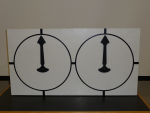 | Dubious Clocks
Two large "clocks" without numbers mounted on the same vertical board. The clocks coincide at zero on each revolution, but differ in their readings elsewhere around the circle. The difference is subtle enough to encourage doubt as to which is "correct." Shows that timing devices can be useful for some measurements but worthless for others. |
| One Liter Cube (1A10.50)
A cube 10 centimeters on a side, disassembles into deciliter, centiliter, and milliliter subsections. |
1A20 - Error and Accuracy | Gaussian Distribution (1A20.10)
Hundreds of tiny balls strike an array of pins, bouncing between them and eventually landing in one of a number of slots below. The center slot will contain the greatest number of balls, and the number of balls in the outer slots will approximately follow a Gaussian distribution. Use the document camera for class viewing. |
| Dice (1A20.15)
A collection of dice for probability and statistics discussions. |
1A30 - Coordinate Systems_th.jpg) | Chalkboard Globe (1A30.40)
A large globe surfaced with a black material that can be written on with chalk. Can be used to draw and discuss polar coordinates. |
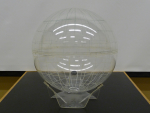 | Acrylic Globe
Clear plastic globe has lines of latitude and longitude drawn on it for discussion of polar coordinate systems. |
1A40 - Vectors_th.jpg) | Vector in Coordinate Frame (1A40.10)
A three dimensional stick-and-ball coordinate frame has a vector arrow emerging from the origin that can be adjusted to any angle within the frame. |
| Vector Components (1A40.13)
A transparent grid with colored transparent arrows pivoting at the origin is used with the document camera to demonstrate the change in vector components with changes in vector angle or magnitude. Both angles with respect to the x-axis and the corresponding x,y position of the vector tip may be read directly from the grid. Different length vectors are available. |
| Folding Ruler (1A40.20)
A folding carpenter's ruler. |
_th.jpg) | Sum Vector (1A40.31)
A pair of acrylic vector arrows make up two sides of a parallelogram, with a tape measure "vector" extending diagonally across the parallelogram to represent the sum of the vectors. Change the angle between the vectors and the length of the sum vector changes in accordance with the parallelogram rule. |
1A50 - Math Topics_th.jpg) | Radian Disc (1A50.10)
A large disc marked off in radians, with a flexible strip of length r to show the derivation of the unit. |
1A60 - Scaling_(1A60.10)_th.jpg) | "Powers of Ten" (1977) (1A60.10)
A ten minute video which uses the notion of powers of ten to compare the relative sizes of objects in the universe, from clusters of galaxies to individual protons. |
| Scaling Cubes (1A60.40)
Twenty seven small wood cubes are stacked together to form a larger cube. The outside surface area of the large composite cube has been painted black, but the other faces of the small cubes are unpainted. Pull the composite cube apart to show the increased surface area of the component cubes vs the composite cube. |
1C - Motion In One Dimension1C10 - Velocity | Air Track - Constant Velocity Glider (1C10.25)
A glider moves on a frictionless air track at constant velocity (except for the bounce at the end). |
1C20 - Uniform Acceleration_th.jpg) | Guinea and Feather (1C20.10)
Two transparent tubes contain paper and an aluminum disc. Free fall times for the discs are compared when the tubes are at atmospheric pressure and when they are evacuated. |
| Different Mass Balls in Free Fall (Galileo's Experiment) (1C20.15)
Drop wood and metal balls of similar diameter but different mass side-by-side and they will strike the ground at almost the same time. Repeat with a ping pong ball to show the effect of air resistance. |
| Air Track - Inclined for Constant Acceleration (1C20.30)
A glider is accelerated on the air track which is raised on one end to various heights. If two (or more) gliders are released with one slightly behind the other they will accelerate at the same rate regardless of mass and will maintain their relative positions. |
| Rolling Ball on Incline with Flashing Lights (1C20.41)
A large metal ball rolls down an inclined track with lights and marks at spacings of 0, 1, 4, 9, 16, 25, and 36 units (1 unit = 8cm). The lights flash simultaneously once per second. Due to the increasing velocity of the ball it will travel farther and farther between flashes and will be directly above a light at each flash. A set of magnetic strips may be pulled off the track and moved to a large magnetic graph board to make graphs of position, velocity, and acceleration vs. time for the ball. |
1C30 - Measuring g_th.jpg) | Timed Free Fall (1C30.10)
An electromagnet drops a ball from heights of 1 and 2 meters. A clock starts upon release and stops when the ball strikes a cup at the bottom. |
| Water Drops in Freefall (1C30.41)
A beaker with a dropper spout releases single drops which fall about two meters into a bucket. Drop rate is adjusted until a new drop is just beginning to fall as the last one strikes the bucket - the time between drops is then equal to the time of fall. By timing ten drops and dividing the total time by ten an accurate measurement of the time of fall can be obtained, and the value of g can be derived. |
| Reaction Time (1C30.55)
Hold a meter stick between a student's fingers and drop the meter stick. The reaction time of the student is found from the distance which the meter stick falls before the student can catch it. |
1D - Motion In Two Dimensions1D10 - Displacement in Two Dimensions | Cycloid Generator (1D10.20)
A large cylinder with lights at different distances from the center rolls along the lecture desk. With the room lights off, the path of each light is seen to be a cycloid. |
1D15 - Velocity, Position, and Acceleration
1D40 - Motion of the Center of Mass | Air Table - Center of Mass (1D40.22)
A rectangular acrylic plate has three fluorescent dots. One is in the center, and two are off to either side. Spin the plate across the air table and the center dot will move in a straight line while the other dots circle around it. Add a weight to either end and the center of mass moves to the dot closest to the weight, so the plate will now spin around that dot as it floats across the table. |
| Air Track - Pendulum Glider (1D40.50)
A pendulum with a heavy bob is mounted atop an air track glider so that the center of mass of the glider/pendulum system is located partway along the pendulum arm; that spot is marked with a fluorescent disc. When the glider/pendulum is set oscillating on the track, both the glider and pendulum bob swing back and forth, but the center of mass as marked by the disc stays still (or moves smoothly down the track if the glider is given a push). Since the eye is easily confused by the motion of the glider, the room lights are turned off and the motion of the fluorescent disc is viewed under UV. |
| Air Track - Inchworm (1D40.55)
Two gliders fastened together with a long strip of spring steel are set on the air track. Give one glider a push and it will move until it reaches the end of the steel strip, when it will exert a force on the second glider and set it into motion. The reaction force exerted by the second glider will bring the first to a halt. Then the second glider strikes the first and the cycle begins again; the two gliders "inchworm" down the track. |
1D50 - Central Forces_th.jpg) | Ball on a String (1D50.10)
A ball on string is swung around to show the basics of circular motion. Run the string through a handheld tube, start the ball spinning with all the string out, and then pull the string through the tube to decrease the radius of the ball's rotation. The ball will gain angular velocity to conserve angular momentum. |
_(1D50.30)_th.jpg) | Rotor (Carnival Ride Model) (1D50.30)
A horizontal disc rotating at about 2 rev/s has a small section of a vertical wall at the edge. At sufficient speed, the centripetal force will keep a small object pressed against the wall without falling down. |
| Bucket of Water (1D50.40)
A bucket containing a few inches of water is swung in a vertical circle without spilling the water. Critical rotational frequency can be approached from the high end if you don't mind taking a chance. For a drier version, try the same effect with the Ball on String, above. |
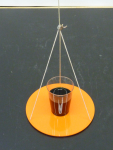 | Greek Waiter’s Tray
A small circular plastic plate hangs from three strings tied symmetrically to its edge. The three strings are tied together at the top so that the plate hangs horizontally beneath them. A small glass of water is placed at the center of the plate. The plate can now be swung around in any direction, and the surface of the water in the glass will always stay parallel to the plate. The plate can also be swung overhead without spilling a drop. |
| Bicycle Wheel with Arrows
A bicycle wheel with cardboard velocity and acceleration vectors for one point on the perimeter. |
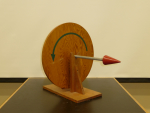 | Arrow Disc
A wooden disc with an arrow showing one direction of rotation and an arrow along the axis showing the direction of the angular momentum vector for that spin direction. |
| Bead on a Rotating Hoop (1D50.57)
A variation of the bead sliding on a hoop that rotates about its vertical
axis. A ball bearing rolls inside a grooved hoop that is spun by a variable speed motor. The motor axis can also be tipped. |
| Rolling Chain (1D50.70)
A loop of brass chain fits snugly on a spinning wooden disk driven by a high-speed motor. The chain is cautiously forced off the disk with a wooden stick and maintains its circular shape as it rolls across the lecture table; it will bounce off an obstacle as though it were a rigid hoop. |
1D52 - Deformation by Central Forces
| Water Paraboloid of Revolution (1D52.20)
A vertical clear cylinder contains colored water; upon rotation the surface of the water forms a paraboloid. |
| Water and Mercury Centrifuge (1D52.35)
A glass globe containing colored water and mercury is spun by a motor. The mercury forms an equatorial band around the globe with the colored water above and below it. |
1D55 - Centrifugal Escape_th.jpg) | Circular Track with Gap (1D55.10)
A ball bearing is rolled around the inside of a circular track. Students predict which path the ball will take when it reaches the opening. Uses the document camera. |
_th.jpg) | Rotating Disk with Erasers (1D55.30)
A horizontal rotating disc with a smooth surface. Chalk board erasers with various surfaces are placed on the disc, which is rotated slowly until the erasers slide off; how long this takes depends on rotation speed, distance from the center, and eraser surface. A weight attached to the rotation axis by a rubber band shows qualitatively how the centripetal force increases with rotation speed. |
1D60 - Projectile Motion_th.jpg) | Vertical Gun on Car (1D60.10)
A vertical spring cannon is mounted to a cart running on a horizontal track. The cannon shoots a small ball vertically while the cart rolls horizontally. Since the cart travels at (nearly) constant velocity, the ball goes up and falls back into the cannon's top, staying directly above the cannon while in the air. Note: The Pasco apparatus can drift after firing. Be sure to check the aiming screws before repeating. |
| Vertical Gun on Accelerated Car (1D60.16)
Same as above (1D60.10), but the car is accelerated either by tipping the track or using a mass on a string. |
_th.jpg) | Drop and Shoot (1D60.20)
A spring shoots one pool ball horizontally while simultaneously dropping another ball vertically. Both balls strike the floor simultaneously. Have a student volunteer catch the projected ball after the first bounce, while you catch the dropped ball. |
| Monkey and Hunter (1D60.32)
A spring powered "gun" points at a "monkey" (a plastic bottle filled with metal shot) hanging from an electromagnet. A plastic slug is shot out of the pipe, displacing a strip of aluminum foil and opening the electromagnet circuit. Thus the monkey begins to fall the instant the "bullet" leaves the tube. Since the monkey and the bullet are in free fall, the bullet will strike the monkey regardless of the curvature of its path. |
_th.jpg) | Range Gun (1D60.40)
A spring launcher shoots a wood ball at various angles and the distance traveled is marked. A large digital stopclock can be used to show times. |
| Air Table - Parabola (1D60.55)
The air table is tilted to produce a small gravitational acceleration and pucks skimmed across the table follow a parabolic path. A video camera shows the view from above. |
1E - Relative Motion1E10 - Moving Reference Frames_th.jpg) | Bulldozer on Plastic Sheet (1D or 2D) (1E10.10)
One battery powered vehicle runs at a constant speed across the lecture table while a second runs across on a large sheet of plastic. Push or pull on the plastic sheet to show how velocities add or subtract. This can be done in one dimension or two; or used for frames of reference discussions. |
_(1E10.20)_th.jpg) | "Frames of Reference" (1960) (1E10.20)
An excellent film (black & white, 1960, approx 28 minutes) showing the apparent motion of objects with respect to various inertial and non-inertial frames of reference. Available on laserdisk or as an MPEG file from https://www.archive.org/details/frames_of_reference. |
1E20 - Rotating Reference Frames | Foucault Pendulum (1E20.10)
The Foucault Pendulum in the A-wing appears to rotate about 11 degrees in one hour, but the Earth is actually rotating underneath. An explanatory plaque is mounted on the wall nearby. |
| Foucault Pendulum Model (1E20.20)
A small model of Foucalt pendulum sits on a rotating plastic disc representing the Earth. Rotate the disc while the pendulum is swinging, and the plane of the pendulum stays constant. |
1F - Newton's First Law1F10 - Measuring Inertia_th.jpg) | Inertia Balance (1F10.11)
A platform is supported by two strips of spring steel, leaving it free to oscillate horizontally. Two blocks of similar appearance but different mass are placed on the platform; the lighter block oscillates at a higher frequency than the heavier block. |
1F20 - Inertia of Rest_th.jpg) | Inertia Block (Inertia Ball) (1F20.10)
A heavy block is suspended between two loops of string. A slow and steady pull on the bottom loop will break the upper string, while a quick jerk will break only the lower string (due to the high inertia of the mass). |
| Table Setting (1F20.30)
Plates and glasses on a paper table cloth. With one swift pull, the paper is removed from under the tableware with no breakage. Easy to do, but practice first. |
| Pipe on Paper (1F20.33)
A large brass pipe rests vertically on a sheet of paper. The paper is quickly snapped out from underneath the pipe which remains standing. |
_th.jpg) | Eggs and Pizza Pan (1F20.35)
Three raw eggs are propped up by cardboard cylinders which are standing on a round baking sheet. The baking sheet sits on three water filled beakers with a beaker directly under each egg. The pie sheet is knocked out by a broom (check on technique!), and the eggs drop straight down into the beakers of water. |
| Air Track - Shifted (1F20.50)
A level air track is shifted side-to-side beneath a glider. With the air turned off, the glider moves with the track. With the air turned on, the glider stays still as the track is shifted due to a lack of accelerating forces and friction on the glider. |
1F30 - Inertia of Motion | Air Track - Glider Inertia (1F30.10)
A glider at rest or in motion on an air track will maintain that state. |
| Air Table - Puck Inertia (1F30.11)
Similar to the air track listed above, but with air jets blowing from beneath a plastic disc. Note: The air track is better for inertia demonstrations because the air table has more turbulence beneath the pucks. |
| Chain Fountain (1F30.15)
A long length of bead chain is coiled up in a beaker. Pull one end up and out of the beaker and the rest of the chain will syphon out of the beaker. |
1G - Newton's Second Law1G10 - Force, Mass, and Acceleration | Air Track - Constant Acceleration Glider with Weights (1G10.10)
Gliders on a level air track are accelerated by weights (large paper clips, approx. 3 grams apiece). |
_th.jpg) | Heavy Cart with Spring or Spring Scale (1G10.15)
A small wheeled cart is pulled along the table by a spring or spring scale with different forces to show different accelerations. The spring will give a smoother indication of a constant force (the scale bounces) but cannot give quantitative results. Weights may be added to vary the cart's mass. |
| Air Track - Glider and Spring (1G10.16)
A light spring scale attached to a glider allows the application of a constant force. |
_th.jpg) | Atwood's Machine (1G10.40)
Two equal masses are attached to either end of a cord running over a pulley. Small additional weights can be added to one of the hanging masses to unbalance to weights and accelerate the system. A stopclock and a two meter stick can be used to show that acceleration is proportional to the unbalanced force. |
1G20 - Accelerated Reference Frames | Dropped Slinky (1B20.45)
Hold a slinky vertically so some of it extends downward, then drop it to show the contraction vs gravitational acceleration. |
| Mass on a Moving Spring Scale (1G20.60)
Hang a mass on a spring scale and then move the scale up and down to change the reading. |
| Air Track - Accelerometer (1G20.70)
An acrylic and water accelerometer is bolted to the top of an air track glider. The surface of the colored water is perpendicular to the gravitational gradient at all times. The glider is placed at the top of a tilted air track with the air turned off, and the water surface is seen to be horizontal, and thus angled with respect to the track. Turn the air blowers on, and as the glider begins its descent the water surface quickly becomes parallel to the track and remains so it reaches the end. |
| Suspended Ball Accelerometers (1G20.76)
Two types: a jar containing water and a lead weight on a string, and the same type of jar with a tethered float underwater. At rest, or at constant velocity, the supporting strings of both are vertical, but under acceleration they move away from the vertical (in opposite directions). |
1H - Newton's Third Law1H10 - Action and Reaction | Note: See Section 1N20 Conservation of Linear Momentum.
|
_th.jpg) | Fan Car with Sail (1H10.20)
A car with onboard fan and removeable "sail." Cart will not move at all with the sail perpendicular to the fan, but moves with the sail removed. |
1H11 - Recoil | Note: See Section 1N22 Rockets.
|
1J - Statics Of Rigid Bodies1J10 - Finding Center of Gravity_th.jpg) | Irregular Objects (1J10.12)
A piece of wood of irregular shape is hung on a metal pin from various points around its edge. Since the center of mass is directly beneath the point of support in each case, one can find it by using a plumb bob to draw vertical lines from two or more points of support - the lines intersect at the center of mass. |
| Meter Stick on Fingers (1J10.30)
Rest a meter stick on two widely spaced fingers, then bring them together. Your fingers will always meet at the center regardless of initial position. The finger closest to the center at any time always supports the greater weight, so its frictional force is greater and it moves more slowly. |
1J11 - Exceeding Center of Gravity_th.jpg) | Leaning Tower of Pisa (1J11.10)
A model tower leans on a slanted base and is stable until a cap is added to the top; that shifts the center of mass outside the base and the tower topples. |
| Human Center of Mass (1J11.40)
Place a piece of tape on the floor and stand with your toes behind the tape. Try to pick up something from the floor 1 meter away without moving your feet. Repeat with your heels square against the wall. |
1J20 - Stable, Unstable, and Neutral Equilibrium_th.jpg) | Stability of Geometric Shapes (1J20.11)
A cone, cylinder, cube, and a sphere are used to discuss stability and equilibrium conditions. The sphere has neutral stability. The cone and cylinder are either in neutral, stable or unstable equilibria depending on how they rest on a surface. |
| Clown on Tightrope (1J20.45)
A toy clown with weighted rods as arms rides a unicycle down a length of string. The clown is stable because the center of mass is below the rope. |
_th.jpg) | Chair on a Pedestal (1J20.51)
A chair with weighted legs balances on a pointed rod. Since the center of mass is below the point of support the chair is stable and may be knocked around without falling over. |
_th.jpg) | Double Cone on Incline (1J20.70)
Two rails fastened together at a small angle form an incline; a cylinder will roll down the incline but a double cone will roll "up" the incline because the widening of the rails allows it to lower its center of mass by moving in that direction. |
1J30 - Resolution of Forces_th.jpg) | Load on Removable Incline (1J30.10)
A cart rests against a support block on an incline. A force can be applied parallel to the incline by a weight strung over a pulley, which is equal to the component of gravitational force in that direction. The support block can now be removed. Another weight is used to balance the normal force perpendicular to the incline; the incline can now also be removed. The cart will remain suspended in air. |
| Forces on a Taut Rope (1J30.25)
A long taut line can be significantly displaced at its center with a small sideways force. Both the sideways force and rope tension can be displayed on spring scales. |
_th.jpg) | Boom and Weight (1J30.40)
A long boom is hinged at one end and supported by a cable at the other end. A large spring scale measures the force on the cable. Weights can be hung along the boom and the spring scale shows the resulting tension in the cable. |
_th.jpg) | Force Board (1J30.50)
Three strings are tied together to a common point, with their other ends passing over three pulleys and supporting three weights. Two different combinations of weights and string angles are available that will leave the common point in equilibrium under the three forces. |
1J40 - Static Torque_th.jpg) | Torque Bar (1J40.10)
A T shaped rod with screw eyes spaced along its length. A weight is hooked to an eye and lifted off the table by twisting your wrists. The farther from your wrists the weight is, the harder it gets. Good for student participation. |
_th.jpg) | Balancing Meter Stick (1J40.20)
A meter stick which pivots at the center is supplied with masses which may be attached to the stick at various points to achieve different equilibria. Masses and distances are all simple 1:2:3 ratios for ease of calculation in class. |
_th.jpg) | Hinge Board (1J40.21)
A flat board with hooks at intervals is attached to the table by a hinge. Lift the board at different distances from the hinge with a spring scale, and observe the force required. |
_th.jpg) | Torque Wheel (1J40.25)
A wheel with coaxial pulleys of 5, 10, 15, and 20 cm to show static equilibrium of combinations of weights at various radii. |
_th.jpg) | Bridge and Truck (1J40.40)
A long board with position markings is supported at each end by a kitchen scale. A 10 lb. toy truck is rolled to different positions along the bridge while the forces at each end of the bridge are indicated by the scales. |
| Roberval Balance (1J40.50)
A simple pan balance is shown to be sensitive to the position of the weights, while the Roberval balance is not. |
| Crank and Axle
An axle with a radius r has a crank handle with a length of 6r. A rope is wrapped around the axle, and a weight hung on the rope can be balanced by a much smaller weight on the crank. |
1K - Applications Of Newton's Laws1K10 - Dynamic Torque_th.jpg) | Ladder Forces (1K10.20)
A model ladder is positioned as though it were leaning against a wall, but is actually supported by three spring scales that provide the horizontal "wall" force and the horizontal and vertical "floor" forces needed to keep the ladder in equilibrium. A weight can be hung from various rungs of the ladder to vary the forces, which are read directly off the scales. |
_th.jpg) | Large Spool with Wrapped Ribbon (Walking the Spool) (1K10.30)
A large spool has a flat ribbon wrapped around its axle several times so that it will come off the bottom of the axle's shank as the spool rolls along the table. The spool will either roll clockwise, counter-clockwise, or slide without rolling, depending on the angle at which the ribbon is pulled. |
_th.jpg) | Loaded Disc Rolling Uphill (1K10.50)
A large disc has a lead weight hidden near one edge, so its center of mass is away from the center of the disc. If it is placed on an incline with the lead weight on the uphill side of the incline, it will roll uphill slightly because that lowers its center of mass. |
1K20 - Friction_th.jpg) | Four Surface Incline (1K20.10)
A board is covered with strips of four different materials (teflon, sandpaper, bare wood, and rubber) that run down the length of the board. Identical brass blocks are placed at the end of each, and the end of the board near the blocks is slowly lifted up. As the angle increases, the blocks will slide down the strip in order of the different coefficients of friction. |
_th.jpg) | Incline with Sliding Blocks (1K20.35)
Blocks with different surfaces are placed on an incline, which is slowly raised until the block just begins to slide down. The tangent of the angle at that point equals the coefficient of static friction between the inclined board and the sliding block. |
| Sliding Chain (1K20.60)
A chain hangs over the edge of the table. The length hanging over the edge is increased until the entire chain starts to slide. |
1K30 - Pressure | Bed of Nails (1K30.10)
Lie down on a bed of nails and let the demo staff smash a cinder block. NOTE: Please see us first before requesting this. |
1L - Gravity1L10 - Universal Gravitational Constant
1L20 - Orbits | Gravitational Well Model (1L20.10)
A sheet of fabric is stretched over a large horizontal loop and then distorted by placing a heavy ball in the center. Smaller balls can then be made to orbit around the potential well. Note: See also Marbles and Funnel (1Q40.70). |
| Orrery
A motorized model of the solar system. |
1M - Work And Energy1M10 - Work_th.jpg) | Pile Driver with Nails (1M10.20)
Five nails are just barely driven into a piece of wood. Masses slide down a rod and strike the heads of the nails one by one, driving them into the wood. The penetration depths of the nails are compared as an indicator of the energy released in four different configurations (two different heights and two masses) versus the control nail. Note: See also Pile Driver with Foam (1N10.30). |
1M20 - Simple Machines | Examples of Simple Machines (1M20.01)
A block and tackle, crow bar, differential pulley, inclined plane, screw jack, and windlass. |
| Pulleys and Mechanical Advantage (1M20.10)
Pulleys rigged in different configurations to show mechanical advantage. |
| Block and Tackle
Lift 50 lbs. with 14 lbs. of force on a spring scale. |
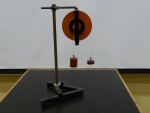 | 4:1 Ratio Pulleys
Two pulleys with a 4:1 diameter ratio are bound together on a common axle. A weight on the large pulley is balanced by four times as much weight on the smaller. |
| Levers (1M20.40)
A meter stick pivots on a knife edge which may be clamped anywhere on the stick. A weight is hung on a moveable hanger on the stick, which is then used as a lever by pulling with a spring scale either: on the other side of the fulcrum (Class I lever); on the same side of the fulcrum (Class II); or between the weight and fulcrum (Class III). Mechanical advantage can be shown. |
1M40 - Conservation of Energy | Bowling Ball Pendulum (1M40.10)
Also called the Nose Breaker. A bowling ball pendulum suspended from the ceiling. NOTE: Only available in A102 and A118. |
_th.jpg) | Galileo's Pendulum (1M40.15)
A pendulum swings in front of a white board with horizontal marks. The string strikes a stationary peg, which stops the top part of the string and shortens the pendulum, but the bob always rises close to the initial height. |
_th.jpg) | Loop the Loop (1M40.20)
A ball rolls down a straight section into a vertical circular loop and then into a uphill incline. |
_th.jpg) | Energy Well Track (1M40.25)
A ball rolls down an incline and up a shorter hill on the other side. If the ball's initial height is below a given mark, the ball will not have enough energy to roll up and over the hill, but will instead roll back and forth between the two inclines. |
_th.jpg) | Triple Angle Track (1M40.33)
Three inclined tracks each have the same downward slope, but different uphill angles on the other side. A ball rolled down each track in turn rolls up the other side to the same height in each case, despite the different slopes. |
| Small Ball Rolling off Large Sphere (1M40.36)
A small ball rolls down the side of a large hemisphere and loses contact midway. |
| Maxwell's Yo-Yo (Maxwell's Wheel) (1M40.50)
A large yo-yo in a slightly different configuration. When released, it will unspool, bottom out, and then wind itself back up close to the release height. |
| Air Track - X^2 Energy Dependence of a Spring (1M40.63)
A spring at the bottom of a tilted air track fires a glider up the track. Spring compressions of 1, 2, and 3 units produce rise heights of 1, 4, and 9 units respectively (compression units are smaller than rise height units). |
| Spring Ping Pong Gun (1M40.64)
A small spring powered toy gun shoots ping-pong balls into the air after you provide the energy to compress the spring. Can also use a heavier wooden ball with the same input energy. |
_th.jpg) | Spring Jumper (1M40.67)
A small jumping toy which shows that a spring may contain enough energy to launch itself into the air. |
_th.jpg) | High Bounce Paradox (1M40.91)
A raquetball that’s been cut in half. Invert the curve of the ball with your hand. When dropped, the ball will pop back upon colliding with the floor, releasing the stored energy you put in and making it bounce higher than the release height. |
1M50 - Mechanical Power_th.jpg) | Prony Brake (1M50.10)
A student cranks on the handle for one minute against a constant frictional force. Knowing the drum circumference, the number of turns (and thus distance traveled), the force, and the time, horsepower can be calculated (about 0.25 hp max). |
1N - Linear Momentum And Collisions1N10 - Impulse and Thrust | Egg in a Sheet (1N10.20)
A raw egg is thrown into a hanging sheet and decelerates without breaking. The same egg may then be broken by dropping it into a beaker. Impulse is actually greater with the sheet, but the beaker produces a greater force over a shorter time and cracks the egg. |
_th.jpg) | Pile Driver with Foam (1N10.30)
A pile driver drops a mass onto a plastic strip and cracks it, but not if a piece of foam is placed on the board. Same impulse, different force and time. Note: See also Pile Driver with Nails (1M10.20). |
1N20 - Conservation of Linear Momentum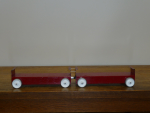 | Reaction Carts
Two rolling carts, one with a spring-loaded plunger, are tied together with a string. The string is burned, and the two carts are pushed apart by the spring and roll away with equal and opposite momentum. A large weight can be added to one cart to increase mass. |
_th.jpg) | See-Saw Center of Mass (1N20.10)
The Reaction Carts are balanced on a long see-saw board so that their center of mass is directly above the fulcrum. The board is horizontal and stable. When the string between the carts is burned, they spring apart with equal and opposite momenta. The center of mass remains above the fulcrum so the board remains balanced (until one cart strikes the end of the board). Most dramatic with different mass carts. |
| Air Track - Reaction Gliders (1N20.20)
Two gliders which spring apart with equal and opposite momenta when the string between them is burned. Mass ratio can be 1:1, 2:1, or 3:1. |
1N22 - Rockets | Rocket Wagon with Fire Extinguisher (1N22.10)
The exhaust from a CO2 fire extinguisher is vented out a tube at the back of a red wagon. Instructor sits on the wagon, fires the extinguisher, and accelerates across the room. "And all this science, I don't understand / It's just my job, five days a week / A rocket man, a rocket man" - Elton John. Note: Please come early for the pre-flight safety briefing. |
_th.jpg) | Water Rocket (1N22.20)
A toy plastic water rocket uses pressurized air as a driving force. The amount of lift varies greatly with the selection of the exhaust: air exhaust will barely move the rocket (low mass transfer), but water exhaust can easily send the rocket to the ceiling. |
_th.jpg) | CO2 Rotator (1N22.33)
A CO2 cartridge is inserted in a cylinder at the end of a rotation arm. When the end of the cartridge is punctured, the escaping CO2 spins the arm in a circle. |
1N30 - Collisions in One Dimension
_th.jpg) | Eleven Pool Balls (1N30.15)
Eleven pool balls are suspended linearly. One or more balls can be separated together and released to collide with the remaining balls, and the same number of balls fly off other end. This is similar to the Newton’s Cradle above, but doesn’t work quite as well because the pool balls have a lower coefficient of restitution than the stainless steel balls. |
_th.jpg) | Collision Balls (Various Masses) (1N30.20)
Two balls are suspended side by side so that one may be swung out and released to strike the other. Available in mass ratios of 1:1, 1:3, and 1:80. Velcro may be used on the 1:1 balls to produce inelastic collisions. |
| Air Track - Elastic and Inelastic Collisions (1N30.30)
Elastic collisions use spring or magnet bumpers. Inelastic collisions use putty. Different masses can be used. |
| Air Track - Spring Compression
An air track glider accelerates down an inclined track and compresses a large spring at the end. |
| Air Track - Double Glider High Bounce (1N30.65)
Similar to the Double Ball Drop above, but much easier to perform. A light glider rests behind a heavy glider on a tilted track, partway up the track. Release them together, and after striking the bottom the light glider will bounce up to three or four times the original release height. |
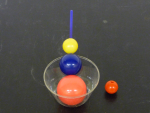 | Astro-Blaster Toy
Five rubber balls of diminishing size are threaded on a common rod through holes in their middles. The balls are free to slide on the rod, but only the top (smallest) ball is free to come off the rod. If the stack of balls is dropped on the floor, the ratio of the ball masses is such that most of the momentum and energy of the four lower balls is transferred into the top ball during the collision with the floor. The top ball flies off the stick to a much greater height than the drop height. |
1N40 - Collisions in Two Dimensions | Air Table - Elastic and Inelastic Collisions (1N40.20)
Two dimensional collisions between pucks having equal or unequal masses, elastic collisions using magnetic pucks, inelastic collisions using Velcro-edged pucks. A camera shows the view from above. |
1Q - Rotational Dynamics1Q10 - Moment of Inertia | Moment of Inertia Rods (1Q10.10)
Two long rods look the same but have different mass distributions (either concentrated at the center or at the two ends). The instructor spins the rod with the mass at the center, while a student spins the rods with the mass at the ends. |
| Rolling Bodies (Discs, Hoops, and Sphere on Incline) (1Q10.31)
Two equal mass and size cylinders with different mass distributions are rolled down an incline simultaneously and the difference in translational velocity is noted. Also a hoop and disc of equal mass, and sphere and cylinder of equal radius and similar mass. |
| Soup Cans on Incline (1Q10.50)
Two soup cans, one filled with a chunky soup and the other with a broth, roll down an incline. |
1Q20 - Rotational Energy_th.jpg) | Angular Acceleration Machine (1Q20.10)
A flat bar free to rotate about its center is accelerated by the torque provided by a string-wrapped disc and hanging weight. Two weights attached to the bar may be removed, placed close to the center of the bar or at the ends of the bar for three different moments of inertia. Accelerating weights may be varied, and can be hung on either a 5 cm or 10 cm disc to change torque - observe varying angular accelerations. |
_th.jpg) | Spool Wheel on Incline (1Q20.30)
A large spool with a small hub rolls down an incline on the hub. When it nears the bottom of the incline the large outer discs touch down and the wheel rolls on the discs instead of the hub. Since points on the edge of the outer discs have a much greater translational velocity than points on the hub, the wheel as a whole gains translational velocity. To compensate, it loses rotational velocity. |
_th.jpg) | Bicycle Wheel on Incline with Lockable Hub (1Q20.35)
A bicycle wheel with a center hub that can be left free to rotate or locked to the wheel rolls down an incline on the hub. When the hub is locked, a large amount of energy must go into the angular momentum of the wheel as it rolls, so the translational velocity is much lower than with the hub free. |
_(1Q20.50)_th.jpg) | Falling Chimney (Faster Than g) (1Q20.50)
Two boards are fixed together by a hinge at one end so as to allow them to fold together. One board is flat on the table and the other board is propped up by a stick, with a ball balanced on a golf tee attached to the end of the board. When the stick is pulled away and the board is released to free fall, there is a torque about the hinge and rotates as it falls. The rotation causes the end below the ball to accelerate faster than the ball and the ball falls into the cup. |
1Q30 - Transfer of Angular Momentum_th.jpg) | Satellite Derotator (1Q30.25)
Two heavy weights on cables are released from a vertically spinning disc to stop the system by conservation of angular momentum. |
1Q40 - Conservation of Angular Momentum_th.jpg) | Rotating Stool and Weights (1Q40.10)
Sit on a rotating stool holding a dumbell in each hand; pulling the dumbells inward will increase your angular velocity, letting them out will decrease it. |
| Rotating Stool and Long Bar (1Q40.15)
Same rotating stool as above; a long hand-held metal rod twisted in one direction will twist the instructor the opposite way. Weights can be added to the bar for a greater effect. |
_th.jpg) | Wheel and Brake (1Q40.45)
A horizontal bicycle wheel is contained in a frame that is free to rotate in the same plane as the wheel. A braking device mounted to the frame is held open by a string; burn the string and the brake clamps down on the wheel, transferring angular momentum from the wheel to the frame and making both rotate together at a lower velocity. |
_th.jpg) | Marbles and Funnel (1Q40.70)
Marbles roll into a large glass funnel. The marbles spiral downward and rapidly increase their rate of rotation, due to conservation of angular momentum. Finally they reach an equilibrium level where they revolve in a nearly horizontal plane, gradually dropping lower as friction slows them down. |
_th.jpg) | Air Rotator with Deflectors (1Q40.82)
A rotating bar has tangential air jets at the ends of the arms and deflectors which may be swung into the air streams. If the deflectors are out of the air streams, the device will rotate like a garden sprinkler. If the deflectors are in, and air velocity is low, no rotation is observed because the reaction force of the air leaving the jet is balanced by the force of the air striking the deflectors. |
1Q50 - Gyroscopes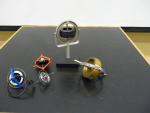 | Gyroscopes
Choose from various gyroscopes, from simple toys to high quality demonstration models. Select this entry for general gyroscope info and references. |
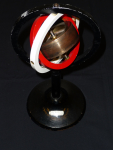 | Handheld Gyroscope
A gimbal mounted gyroscope will maintain its axis of rotation when it is moved around the room. |
_th.jpg) | Bicycle Wheel Precession (1Q50.23)
A bicycle wheel with handles which may be spun up with a string wrapped around the hub. It can then be suspended by a rope tied to one handle to show precession. Will also precess when stood on its end like a top. |
_th.jpg) | Double Bicycle Wheel (1Q50.25)
Two bicycle wheels on a common axis. If they are rotating in the same direction they will precess, but if they are rotating in opposite directions their net angular momentum is zero and they simply fall over. |
_th.jpg) | Motorized Gyroscope (Precession and Nutation) (1Q50.30)
A motorized gyroscope with a heavy flywheel on gimbals. Weights may be hung from the end of the bearing arm to produce precession and nutation. The flywheel takes over a minute to come up to full speed, and if a weight is hung on the arm when the spin is still slow, precession will initially be rapid but will slow down as the flywheel speeds up. |
| Gyroscopic Ship Stabilizer (1Q50.72)
A motorized gyro is free to pivot when a ship model is rocked. |
1Q60 - Rotational Stability | Euler's Disk (Spinning Coin) (1Q60.25)
A disk spins without slipping on a smooth surface. |
| Spinning Football (1Q60.35)
Spin a football on its side and it raises up on end. Note: Please practice first. |
| PhiTOP (1Q60.36)
A solid prolate ellipsoid that has an eccentricity of the golden mean, Φ=1.618… When spun quickly, it will rise up and spin on its end like a football or egg. |
1R - Properties Of Matter1R10 - Hooke's Law | Hooke's Law (Mass on Spring) (1R10.10)
Hang weights on a spring and measure the displacement. Note about tapered springs: Tapered springs, when suspended from the thinner end, will have a longer range of linear extension than non-tapered springs. |
1R20 - Tensile and Compressive Stress_th.jpg) | High and Low Elastic Limits (1R20.11)
A plastic slinky spring may be stretched a long way and will still return to its original length. A copper coil stretched even a short distance won't return to its original length. |
_th.jpg) | Young's Modulus (1R20.15)
A long wire mounted in a vertical stand has a weight hanger on one end and a small platform partway down on which a pivoting mirror sits. Add weights to the weight hanger and the wire stretches, pivoting the mirror and deflecting a laser beam. The spot on the wall moves farther with each added weight. |
| Bending Beams (1R20.20)
Three flat bars of different lengths and thicknesses are mounted on the lecture desk so that they project over the edge. Weights are placed on the ends of the bars to compare the deflection. |
1R30 - Shear Stress | Stress and Strain (1R30.20)
A rectangular block of foam rubber stretches to show various stresses and strains. |
| Torsion Rod (1R30.40)
A metal rod has a large disc attached to the end. Weights are hung off the edge of the disc, twisting the rod. A pointer arm shows the amount of twist. |
1R40 - Coefficient of Restitution | Coefficient of Restitution (1R40.10)
Balls of different materials fall down a glass tube and bounce off a hard surface at the bottom. The square root of the ratio of rebound height to initial is the coefficient of restitution. Varies from around 0.95 (glass) to 0.00 (lead). |
_th.jpg) | Happy and Sad Balls (1R40.30)
Two rubber balls that look similar but have different elasticities are dropped on a table. One bounces, one doesn't. |
1R50 - Crystal Structure | Bravais Lattice Models
Unit cells of the 14 Bravais lattices. |
| Crystal Models (1R50.20)
Models of various crystals. |
|

_th.jpg)
_th.jpg)

_th.jpg)
_th.jpg)
_th.jpg)
_(1A60.10)_th.jpg)
_th.jpg)
_th.jpg)
_th.jpg)
_th.jpg)
_th.jpg)
_(1D50.30)_th.jpg)


_th.jpg)
_th.jpg)
_th.jpg)
_th.jpg)
_th.jpg)
_th.jpg)
_th.jpg)
_th.jpg)
_(1E10.20)_th.jpg)
_th.jpg)
_th.jpg)
_th.jpg)
_th.jpg)
_th.jpg)
_th.jpg)
_th.jpg)
_th.jpg)
_th.jpg)
_th.jpg)
_th.jpg)
_th.jpg)
_th.jpg)
_th.jpg)
_th.jpg)
_th.jpg)
_th.jpg)
_th.jpg)
_th.jpg)
_th.jpg)
_th.jpg)
_th.jpg)
_th.jpg)
_th.jpg)
_th.jpg)
_th.jpg)
_th.jpg)
_th.jpg)
_th.jpg)
_th.jpg)

_th.jpg)
_th.jpg)
_th.jpg)
_th.jpg)
_th.jpg)
_th.jpg)
_th.jpg)
_th.jpg)
_th.jpg)

_th.jpg)
_th.jpg)
_th.jpg)
_th.jpg)
_th.jpg)
_th.jpg)
_th.jpg)
_th.jpg)

_th.jpg)
_th.jpg)
_th.jpg)
_(1Q20.50)_th.jpg)
_th.jpg)
_th.jpg)
_th.jpg)
_th.jpg)
_th.jpg)
_th.jpg)
_th.jpg)


_th.jpg)
_th.jpg)
_th.jpg)
_th.jpg)
_th.jpg)
_th.jpg)
_th.jpg)
_th.jpg)
_th.jpg)